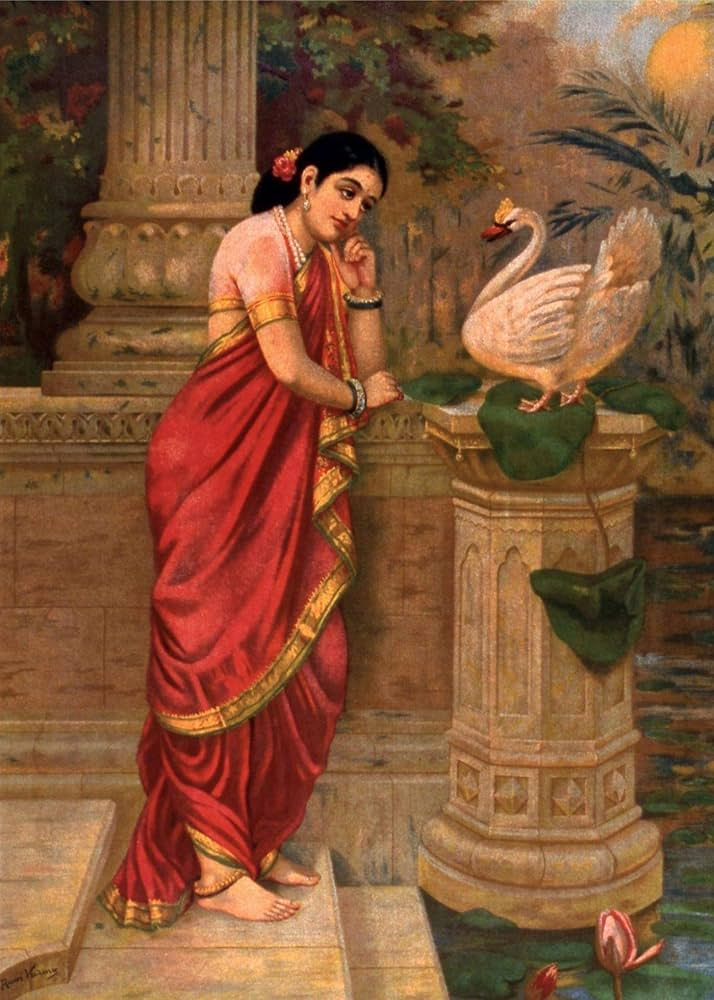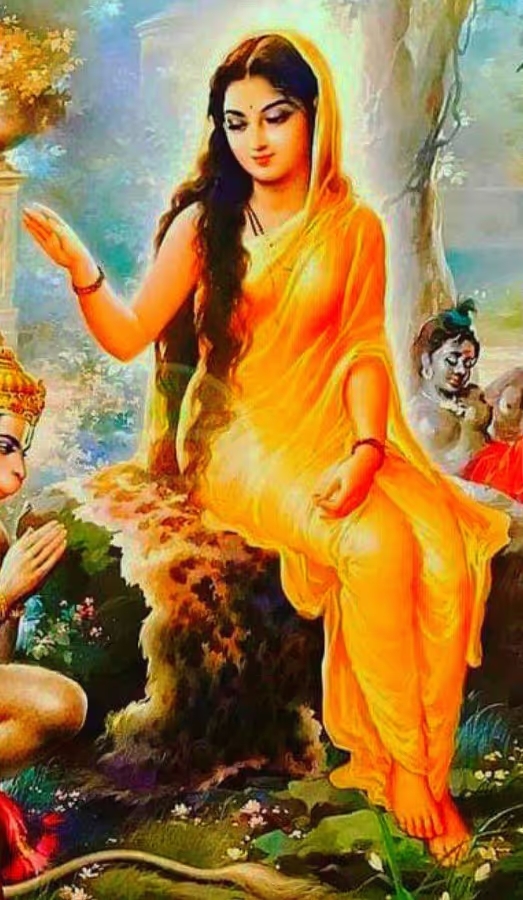Divine Saundarya in Sanatan Sanskriti: Stories of Pauranic Women Who Shaped Dharma
- Chinmayi Devi Dasi

- Aug 22
- 5 min read
Unveil the meaning of Divine Saundarya in Sanatan Sanskriti – where beauty of Pauranic men and women reflected inner strength, dharma, and timeless Sanatan wisdom.

Sanatan Sanskriti has always celebrated Saundarya (beauty) not as mere physical charm, but as a reflection of Dharma, Bhakti, and inner purity. Our epics and Puranas are filled with descriptions of men and women whose radiance was not limited to their outer appearance but flowed from their virtues, devotion, and inner strength. In Sanatan vision, Saundarya is the swarupa of divinity—it is both external grace and inner sattva.
As the Rigveda declares:
“कामस्तदग्रे समवर्तताधि मनसो रेतः प्रथमं यदासीत्” (ऋग्वेद 10.129.4)
Kama (divine desire) was the first seed of creation, beauty and love being its essence.
The Concept of Saundarya in Sanatan Sanskriti
The Vedic sages considered Kāma (desire or love) as the root of creation itself. The Rigveda says:
"Kāma was the first seed of mind, born at the beginning" (Rigveda 10.129.4).
This shows how deeply love and beauty are linked to human life. Thinkers like Bhavabhūti believed that true love is unconditional, yet many poets saw love arising from attraction—whether through sight, sound, or presence. Attraction always flows towards beauty, and therefore the concept of beauty in literature became inseparable from the idea of love.

Beauty as Ālambana Vibhāva
In Sanskrit poetics, beauty is often described as Ālambana Vibhāva, the source that inspires emotions. Since Śṛṅgāra rasa (the sentiment of love) depends on mutual affection, both the lover and the beloved are shown as beautiful and charming. This is why Sanskrit poets created characters of extraordinary grace and attractiveness.
Beauty in the Ramayana and Mahabharata
Valmiki, the first poet, described Rama and Sita as embodiments of beauty in the Ramayana. Even Ravana and his queens were given an aura of charm.
Similarly, Vyasa in the Mahabharata and Puranas presented not just the heroic deeds of great figures but also their physical and spiritual beauty. Krishna is described as enchanting the three worlds, while Lakshmi and Mohini are praised for their unmatched radiance during the churning of the ocean. Characters like Draupadi, Kunti, and Madri were portrayed as timeless ideals of feminine beauty.

Kalidasa and the Golden Age of Aesthetics
No discussion on aesthetics in Sanskrit literature is complete without Kalidasa, often called the greatest poet of classical India. His works introduced characters of extraordinary charm: Dilipa, Raghu, Dushyanta, Shiva, and female figures such as Parvati, Shakuntala, Urvashi, and Malavika.
Kalidasa’s descriptions of their grace and personality highlight the deep aesthetic sense in Sanskrit poetry, where beauty is not just physical but also spiritual and emotional.

The World of Beauty in Later Literature
Later poets like Sriharsha described the love story of Nala and Damayanti, with special attention to Damayanti’s enchanting beauty. Similarly, Bana, in his Kadambari, created a unique world of divine charm. His imagination brought forth characters like Mahashweta, Pundarika, and Kadambari herself, who belong to an almost otherworldly realm of beauty.
Bhavabhūti, though more restrained, also expressed his aesthetic ideals in works like Malati-Madhava and in his depictions of Rama, Sita, Lava, and Kusha.

In Sanatan thought, Saundarya is not skin-deep. A person’s charm shines only when it is supported by Dharma and character. Bhagavad Gita reminds us:
“उद्धरेदात्मनात्मानं नात्मानमवसादयेत्।
आत्मैव ह्यात्मनो बन्धुरात्मैव रिपुरात्मनः॥” (गीता 6.5)
One’s beauty is uplifted when the self is uplifted through discipline and purity. Hence, in epics, both outer beauty and inner strength are praised together.
The Radiance of Women in Pauranic Bharat
1. Ahalya – The Redeemed Beauty
Ahalya, wife of sage Gautama, was known for her divine grace. When Indra deceived her, she was cursed into stone, yet her redemption came when Lord Rama’s feet touched her. Here Saundarya represents not just form, but also purification and spiritual rebirth.

2. Damayanti – Beauty with Wisdom
Princess Damayanti’s charm was so enchanting that even gods attended her swayamvara. Yet her intelligence allowed her to recognize King Nala among divine illusions. Her beauty thus became a symbol of viveka (discrimination) and loyalty.

3. Menaka, Rambha, and Urvashi – Apsaras of Celestial Grace
These apsaras embodied such radiance that even mighty sages like Vishwamitra were tested. Menaka’s daughter Shakuntala carried this lineage of Saundarya forward, giving rise to Bharat, the ancestor of the Kuru dynasty. Urvashi’s tale with Pururava and her later encounter with Arjuna show how beauty could both enchant and test Dharma.

4. Sita – The Golden Radiance
Sita Mata’s Saundarya is described as glowing like molten gold. When Ravana first saw her, he was struck speechless. But her true beauty lay in her pativrata dharma—her devotion to Rama, patience in exile, and courage in trials.

5. Satyavati – The Queen of Destiny
Though born to a fisherman, Satyavati’s charm captivated sage Parashara and later King Shantanu. Through her, the lineage of Vyasa, Bhishma, Pandavas, and Kauravas emerged. Her beauty was not just external—it shaped the destiny of Bharat.

6. Rukmini and Radha – Eternal Love and Devotion
Rukmini, incarnation of Lakshmi, longed only for Krishna. Her Saundarya lay in her unwavering devotion. Radha, beyond physical beauty, became the symbol of param bhakti—where love itself transforms into divine Saundarya.

7. Draupadi – Born of Fire
Draupadi, “Yajnaseni,” was born from sacrificial fire. Her beauty was fiery, commanding respect even from kings. Yet her dignity during humiliation in the Kaurava court showed the strength of Sanatan womanhood—beauty that refuses to bend against adharma.

8. Satyabhama – Beauty with Valor
Satyabhama, Krishna’s beloved, was blessed with eternal youth and courage. She fought alongside Krishna against Narakasura. Her beauty was not fragile—it was radiant with shakti and determination.

Male Saundarya in Sanatan Dharma
Sanatan Sanskriti never limited Saundarya to women. The epics celebrate the extraordinary beauty of men as well.
Shri Rama is called “कोमलाङ्ग, चिरंजीव, धीर”—with lotus-like eyes, a golden glow, and noble form.
Shri Krishna is praised as “त्रिभुवनमनोहर”—so enchanting that even Kamadeva bowed before him. In Bhagavatam, his form is described:
“बर्हापीडं नटवरवपुः कर्णयः कर्णिकारं…” – Krishna with peacock feather and flute, radiating divine charm.
The Pandavas are often admired for their heroic build and radiant personalities. Arjuna’s grace and Bhima’s mighty form symbolized Saundarya of valor.
Thus, Saundarya in men was seen as a blend of वीरता (valor), धैर्य (courage), and तेजस्विता (radiance).
The Bhagavad Gita on True Saundarya
Outer beauty is fleeting. The Gita teaches us that the real beauty lies in inner discipline, devotion, and detachment:
“विहाय कामान्यः सर्वान्पुमांश्चरति निःस्पृहः।
निर्ममो निरहङ्कारः स शान्तिमधिगच्छति॥” (गीता 2.71)
One who renounces desires, ego, and selfishness shines with inner Saundarya. True radiance flows from the soul, not the skin.

In Sanatan philosophy, beauty is not a distraction but a form of Shakti. When aligned with Dharma, it uplifts the world. When misused, it can lead to downfall—as seen in stories of Ravana’s desire for Sita or Indra’s misuse of apsaras.
Thus, Saundarya is both a test and a blessing. It is divine when it shines with purity, devotion, and righteousness.
Saundarya in Sanatan Sanskriti: Conclusion
Sanatan Sanskriti’s vision of Saundarya goes far beyond physical charm. The women of Puranic Bharat—Ahalya, Damayanti, Sita, Draupadi, Radha, Rukmini, and many others—were not only admired for their beauty but revered for their Dharma and Bhakti. Men like Rama and Krishna too embodied Saundarya as grace, valor, and divine charm.
In the light of Sanatan Dharma, true Saundarya is not in form but in atma-bhava—the inner radiance of purity, strength, and devotion. It is the glow of Dharma that makes beauty eternal.
“सौन्दर्यं धर्मे लीनं, भक्तौ प्रकाशितं, आत्मा में शाश्वतम्।”
(Beauty dissolves in Dharma, shines in devotion, and becomes eternal in the soul.)



Comments